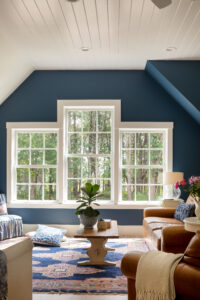When it comes to decorating your home, the ceiling is often the last place people look—yet it holds tremendous design potential! Along with wainscoting and crown molding, ceiling detailing can bring loads of character and architectural depth to both traditional and modern interiors.
Let’s dive into some classic ceiling details found in homes all around the world:
Coffered Ceilings
While floors and walls typically get all the attention, ceilings have quietly been home to some of history’s most beautiful design elements. Coffered ceilings, which are a hallmark of classical architecture, are no exception.
These grid-style ceilings (which feature recessed square or rectangular panels) have been around since ancient Rome but became popular again during the Renaissance period and have stayed in style ever since. The original design was meant to be structural, but now they’re mostly decorative and a great way to add a touch of texture overhead.
Today, coffered ceilings work surprisingly well in all kinds of homes. They add a sense of sophistication without feeling overly formal, especially when paired with warm wood finishes or soft lighting.

Coffered Ceilings: Everything You Need to Know by Angi
Photo Credit: bmak | Adobe Stock
Other Ceiling Styles Worth Considering
Ceiling details don’t have to be ornate to make an impact in your space. Here are a few other styles that can bring personality and dimension to a room:
- Tray Ceilings: With a raised center section that adds depth, tray ceilings are a favorite in the primary bedrooms and dining rooms, especially when accented with lighting or a bold paint color inside the tray.
- Beam Ceilings: Whether they’re functional or just for looks, exposed beams (especially in darker wood tones) can add contrast and help ground a space. They’re perfect for adding a rustic touch and are commonly found in farmhouse-style homes.
- Shiplap & Wood Paneling: For a cozy, coastal, or cottage look, adding wood paneling to ceilings creates warmth and texture, and especially works well in kitchens, sunrooms, or other gathering areas.
- Cathedral Ceilings: Cathedral ceilings dramatically open up a space and are perfect for great rooms, primary bedrooms, or entryways. The upward pitch draws the eye and provides space for statement lighting, skylights, or exposed beams.

Kittery Point Colonial by Amy Dutton Home
Photo Credit: Rachel Sieben Photography
Wainscoting & Crown Molding
While ceiling details do a lot of the heavy lifting, they really shine when paired with the right wall details. Let’s take a look at two elements that can really make a statement:
1). Wainscoting has been around since the 1500s. It started out as a way to insulate walls, but now it’s used to add style and structure to a space. By covering the lower portion of the wall with wood paneling, it helps break up large spaces and adds subtle definition without the need for extra furniture or dividers.
2). Crown molding is the finishing trim that sits at the top of a wall, creating a polished transition from wall to ceiling. While it originated in ancient Greece, crown molding still works beautifully across a range of interior styles in modern day.
Here are a few of the most common crown molding styles you’ll see today:
- Traditional: A classic, curved design that works well in just about any formal or classic setting. Traditional crown molding is versatile and commonly used in living rooms, dining rooms, and entryways.
- Cove: Smooth and simple, cove molding has a gentle curve that feels clean and modern, and is great for more minimalist or contemporary homes.
- Dentil: Recognizable by its small, repeating block pattern, dentil molding has a more decorative, historic feel and is often seen in colonial or traditional-style homes.

Transitional Farmhouse by Amy Dutton Home
Why These Details Still Matter
What makes details like coffered ceilings, wainscoting, and crown molding so timeless is their versatility. They bring a sense of craftsmanship and structure to a room without ever feeling trendy or overdone. So, next time you’re looking up at a blank ceiling, think of it as a blank canvas.. with the right details, it might just become your favorite part of the room.
Thinking about incorporating architectural details into your home’s interior, but not sure where to start? Book a free 15-minute consultation with us today to explore your options!
